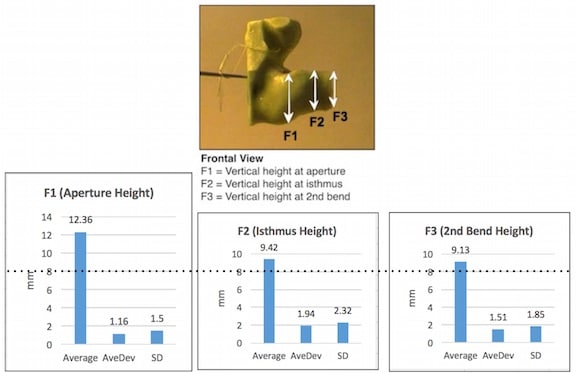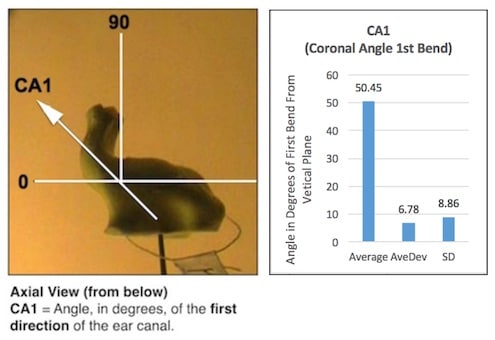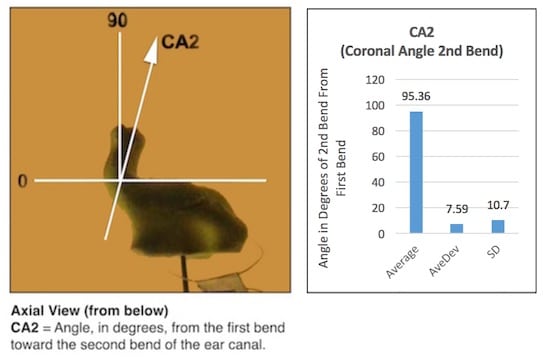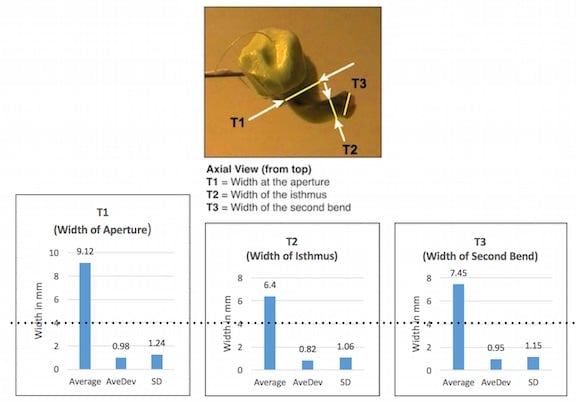Why Ear Canal Dimensions of Asian Females?
Ear canal dimensions (measurement and shape) are important when designing many devices for the ears. This is true regardless of whether the device is custom made, or if it is an off-the-shelf product designed to fit multiple ear canals. For custom products, the dimensions are helpful in designing internal component placement. For off-the-shelf products, the shape and range of dimensions provides directions for the general design and expected percentage of the population that would be able to wear the device.
Although the complete range of ear canal dimensions provides information for the population, it is often the smallest ear canal dimension that determines whether components will fit, or if the end product can be inserted and worn in the ear canal with a high degree of cosmetic appeal and comfort. Because of this, a decision was made to measure the silicone impressions made of Asian female ear canals, making an assumption that these might provide a picture of small adult ears. The subject population consisted of Chinese descent from Hong Kong. Although the right ear impression is used for the images, the measurement identification areas are the same as for the left ear.
Editor’s Note: These data have not been reported previously, but have been languishing like couch potatoes in my computer ever since the measurements were made. It is time that they were made public.
Subjects
The ages of 56 females ranged from 19 to 83, with an average age of 63.2, and a standard deviation of 16.76. Ear impressions were made for 31 right ears and 25 left ears. For no subject were the right and left ear both used, so these measurements represent 56 different individuals, which is expected to provide a wider range of dimensions than if two ears of he same person were measured. Silicone was used to obtain the ear impressions for all subjects.
Measurement Orientations
Figures 1 through 5 provide angles and ear impression orientations for the measurements made. The intent was to record dimensions from the ear canal aperture (ear canal opening) to just into the area of the second bend of the ear canal. There was no attempt to measure the length of the ear canal because complete ear impressions that included the tympanic membrane were not obtained, and this was not the interest of the investigation. The measurements are based on best readings using a caliper (for physical dimensions) and protractor (for angles), and not with a visual comparator or similar device. Each ear impression was tagged with a string and subject identification attached for later measurements and confirmations.
Vertical Height of Aperture, Isthmus, and Second Bend
Figure 1 shows the impression and data as viewed from the front. The aperture (F1) is the opening of the ear canal and lies somewhat coincident with the first turn of the ear canal. The concha is not included in this description. The ear canal isthmus (F2) is the narrowest section of the ear canal, and lies between the first and second bend of the ear canal. F3 identifies the second bend of the ear canal.

Figure 1. Frontal view and height dimensions in mm for the aperture, isthmus, and second bend of the ear canal. (n=56)
Vertical Angle of the Ear Canal from the Aperture to Second Bend
The upper and lower angles (in degrees) of the ear canal are shown from the aperture to the second bend in Figure 2. Measurements, made from the 0 degree plane (horizontal line) and rounded to the nearest 5 degrees, are shown below the image. The general direction of the ear canal is upward toward the second bend. The slope of the bottom angle is greater than that of the top angle, giving rise to the upward direction of the ear canal.

Figure 2. Frontal view showing the angles, in degrees, of the top and bottom edges of the ear canal as directed toward the second bend. (n=56)
Angle, in Degrees, of the First Turn of the Ear Canal
The first direction (in degrees) of the ear canal is recorded based on the markings of Figure 3. Measurement was made from the 0 degree plane and rounded to the nearest 5 degrees with the data recorded on the right side of the figure. That angle is about 50 degrees toward the front of the head.

Figure 3. Axial view of the measurement method used to determine the angle of the first bend of the ear canal. Measurement was made from a line drawn through the center of the first bend from the concha. (n=56)
Angle, in Degrees, Toward the Second Turn of the Ear Canal
Figure 4 shows the angle, in degrees looking toward the second direction of the ear canal from the first bend. Measurement is made from a 0-degree plane at the first bend, and rounded to the nearest 5 degrees. The measurement data is recorded to the right of the image, showing that following the first bend, that the direction of the ear canal is toward the rear of the head, up to the second bend of the ear canal. At the second bend (not shown), the ear canal is directed forward somewhat.

Figure 4. Axial view of the measurement method used to determine the angle of the second bend of the ear canal, relative to a line drawn through the center of the first bend of the ear canal. The angle, in degrees, is measured from this plane and rounded to the nearest 5 degrees. (n=56)
Critical Width Dimensions of the Aperture, Isthmus, and Second Bend of the Ear Canal
In T1, T2, and T3 (Figure 5), the ear impression is viewed from the top looking down. These are critical dimensions because they show the range of variation required of any device that is to be placed in the ear canal. Measurement data, in mm, is shown below the measurement image.
T1 measures the horizontal width of the ear impression at the opening of the ear canal.
T2 shows the measured horizontal width of the narrowest portion of the ear canal as evidenced by the ear impression. This is the area of the isthmus.
T3 is the measured horizontal width of the area of the second bend of the ear canal. It is beyond this location that the ear canal tends to widen again for a short distance before reaching the tympanic membrane.

Figure 5. Axial view of the width of the ear canal, in mm, for the aperture, isthmus, and second bend.








I have been studying external ear dimensions since late 2006, but have not delved into the ear canal dimensions. However, I have been asked questions about the “angle” of the ear canal opening by a student at Texas Tech and become curious enough to learn more. This set of discussions is for me an amazing discovery. Still, I am not clear if any of the studies define orientation of the ear canals relative to the head principal planes, such as the “alleged” plane of symmetry (or Cranial Midsagittal Plane), or the Frankfurt Plane -though the two Orbitale landmarks and the left Tragion landmark (alternate definition is sometimes through the left and right Tragion and one Orbitale landmark). There also may be others. As a former design engineer, I am very curious about the concha as regards hearing aids and the like, but have not found a suitable three-dimensional coordinate system, nor many data. My sources have been largely from plastic surgeon articles and an unpublished doctoral thesis. of M. M. Madzharov, written in 1986. About a third is still in the process of translation.
You are correct in finding most information on this topic in articles related to plastic surgery. However, finding the angle relative to the head principle planes seems to be missing. We can look at this from ear impressions, but trying to build an angle from the “vertical” external ear has many difficulties.